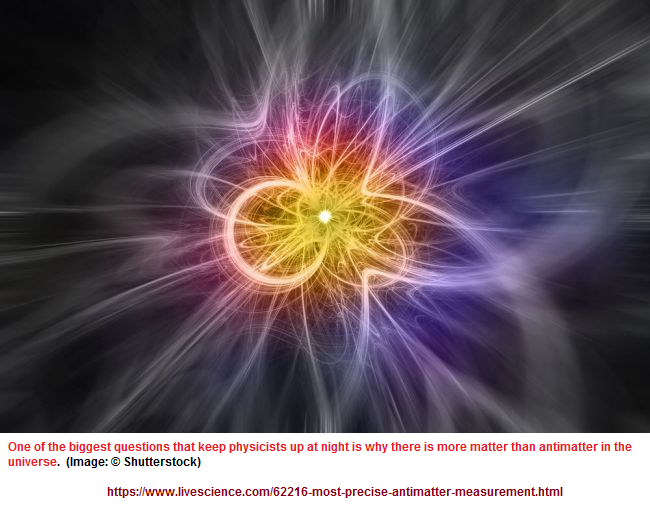~ 30, part A ~
~ The Study of Threes ~
http://threesology.org
Researchers as of 8/29/2019
| Devil's Advocate Series: | ||||||||
|---|---|---|---|---|---|---|---|---|
| 1 | 2 | 3 | 4 | 5 | 6 | 7 | 8 | 9 |
| 10 | 11 | 12 | 13 | 14A 14B |
15 | 16 | 17 | 18 |
| 19 | 20 | 21 | 22A 22B |
23 | 24 | 25 | 26 | 27 |
| 28 | 29 | 30 A | 30 B | 31 | 32 | 33a | 33b | 33c |
| 34 | 35 | 36 | 37 | 38 | 39 | 40 | 41 A | 41 B |
I am prompted to direct the information of this page, at least initially, towards highlighting recurring cognitive patterns in experimentation, particularly those held in high esteem by different researchers in their respective fields; but that we need to become suspicious of in light of acknowledging the presence of recurring cognitive themes taken as paradigms of truth. For example, the two-patterned ideas promoted as "The Double-slit" experiment in physics, and the "Double-blind" study used variously in psychology and drug-related trials... to which one might add the test of identification between two presented options (like a true/false test) when confronted by an optical illusion or mirage, such as for example (22 illusions which prove your brain sucks):
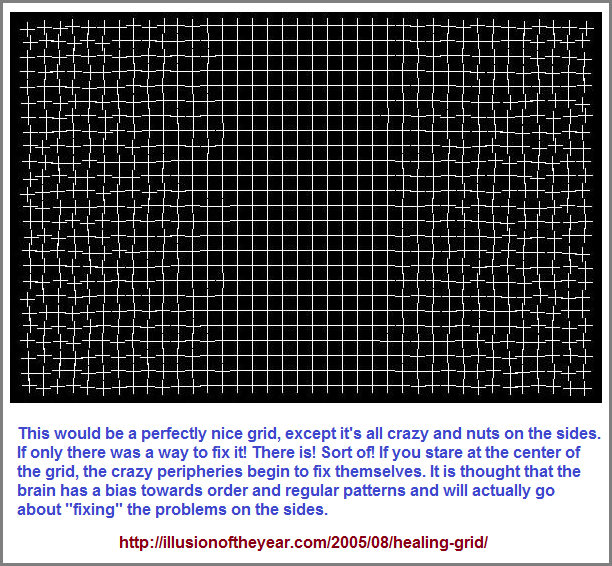 |
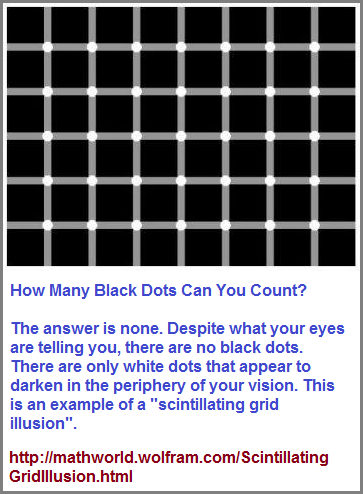 |
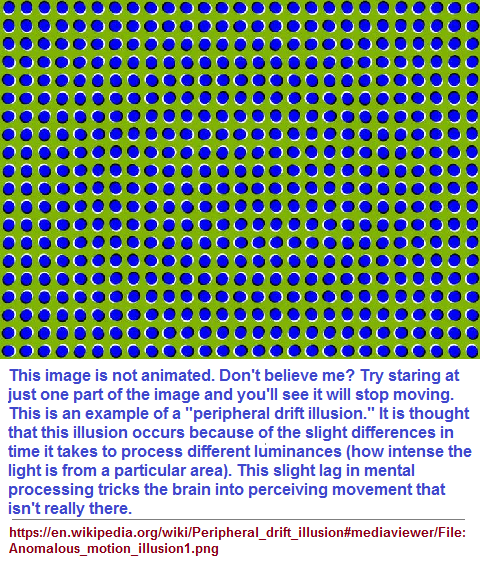 |
|
People are fascinated by illusions and mirages, and ideas involving mixed perceptions and vantage points... like Einstein's Theory of General Relativity involving one's contrasted perceptions of a train while sitting inside looking out or standing outside looking in with respect to a beam of light and his Special Relativity theory involving a stationary and moving clock... both of which are particularly simplistic analogies involving relative position within a typically unvoiced parameter of triangulation... unless you prefer to note the ideas as metaphors, thus creating yet another instance of a linguistically designed alternation of perception.
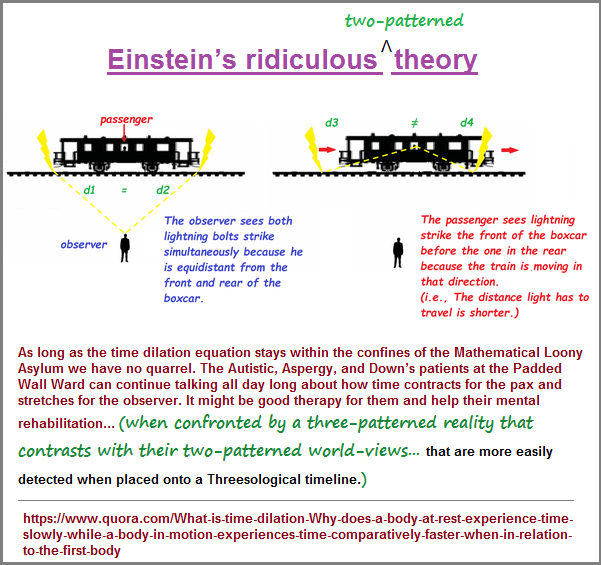 |
How we know that Einstein's General Relativity cannot be quite right by Sabine Hossenfelder, Saturday, August 17, 2019 This discussion brings to the fore the mention of singularity and double-slit ideas, which, when placed into the context of a "Threesological" timeline perspective, generates the possibility that the sought-after theory involves a step beyond the one (singularity)- two (double-slit phenomena)- into a third realm, even though current orientations are collectively focused on a quantum ("many") perspective like primitives whose brains were tackling the need for developing a number system to coincide with business interests of accounting for specificities of goods and services that the word "many" (as a formulated generality) did not provide the accuracy for; just as I suspect the word "quantum" is a similar form of cognitive distraction delineating a cognitive limit suffused with the wrangling of various two-patterned convolutions. |
In addition, please note that attributive discussions in the Hossenfelder blog refer to the duality of low and high energy physics which plays out like a black and white checkers game or two-patterned game of chance in its usage as a mediator of intended thrusts to think beyond the current waves of ideas acting as constraints which detour a person from venturing onto that landscape of cognitive unfamiliarity, like an early hominid braving the trespass into a territory not customarily sojourned by any of their tribe... and routinely seen in religious arguments contrasting the supposed presence of a God/good with Satan/evil, used by many a parent and other authority figure to wield obedience of thought and action to accommodate the interests of a select few wishing to control the many for personal institutional inclinations. Such dualities need to be noted, along with the absence of other enumeratable orientations such as patterns-of-three, four, five, six, seven, eight, nine, etc..., whether they have relevance or not aside from participating as part of the underlying dialogue of consideration as a noted illustrative absence in the cognitive exercises alternatively described as thought experiments or philosophical meanderings. (Which should involve making reference to the three geometric forms of a linear-circular-triangular configuration being hinted at.)
Hence, we see various dualities cropping up in the discussions often involving three particles:
- Low Energy/ High Energy
- "Light" matter/ Dark matter (hmm, no grey matter?)
- Matter/ Energy
- Static/ Dynamic
- Certainty/ Uncertainty
- Singularity/ Multiplicity
- Particle/ Wave (Wavicle?)... or viewed geometrically, we have a circular and triangular configuration but no linear one... as of yet.
2 no-Body problems
- One-body (Central Force): No problem
- Two-body: No problem
- Three Body: Tis a problem
- Mass/Energy equivalency
- Complementarity (physics)
- Dual resonance model
- Duality (electricity and magnetism)
- Englert–Greenberger duality relation
- Holographic duality
- Kramers–Wannier duality
- Mirror symmetry
- 3D mirror symmetry
- Montonen–Olive duality
- Mysterious duality (M-theory)
- Seiberg duality
- String duality: Class of symmetries in physics that link different string theories... Ideas which assume that the fundamental building blocks of the
universe are strings instead of point particles. (Instead of being circular, they are linear and not triangular or some other supposed geometry.)
- S-duality
- T-duality
- U-duality
- Wave-particle duality
Wikipedia: List of dualities
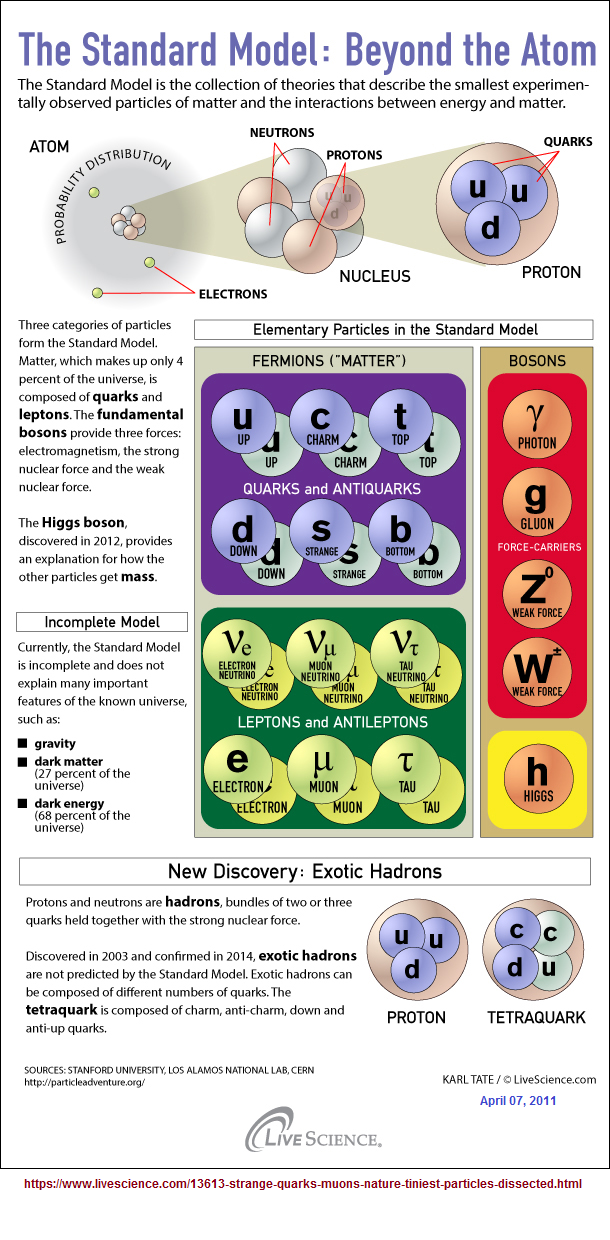
If one exams different ideas we find that when a contrasting point of view is offered in an uncommon or unusual or though of but unspoken way, a simple pattern-of-two is experienced as a moment of Eureka! No doubt the idea of good and evil like fire providing warmth at one distance was contrasted by being burnt at another distance. Similarly, the dualities presented by the Yin/Yang perspective is no doubt found to be a revelation to those who are not familiar with the personal task of mentally cataloguing a list of two-patterned ideas, just as are those when they catalogue a list of some other number organizing material such as seven items, six items, five items, four items, three items, singularities, etc... An accumulation of a given pattern typically presents the notion of at least a possibility that there is a reason... some meaning why there are so "many" or numerous examples. However, let us ask whether it is the idea or the underlying pattern being offered in an unfamiliar (or unfamiliarly defined)... or defined with words and/or symbols interpreted to be superior, divine, etc., which gives added importance to an otherwise simplistic pattern?
We must also become wary of the language being used to describe what some believe to be the final word on a topic such as Quarks being the definitive sub-atomic particle of all particles. I had to insert the word "considered" into the following imaged information, just as we should do so when confronted by ideas asserting that a particular religion's perspective of a singular god is THE representative model all need to believe in... which is then used to exploit the people to serve the interests of a few who claim that their leadership is of primary importance to survive and prosper. Very often we find that generalities are being used to conceal the presence of some definitives which need to be shown in order to gain a greater comprehensibility of an underlying and overall pattern which may be out of context since it neither corresponds to a cognitive pattern frequented by users from different perspectives nor is appropriately explained as to why it takes on the form it does as a fractionated representation, unless this is an exercise in devising a means to profile that which has no actual personality so as to socialize it for further conversation, like an artificially placed "conversation piece", so often seen in supposed serious discussions. (For example, what interests some people is the personalities and personal lives of a given sports or celebrity figure, and that which they do as a profession is a secondary or tertiary issue of concern, though in pointing it out, they might well disagree, or otherwise be viewed as engaging in an interest in superficialities then the initially perceived context of occurrence.)
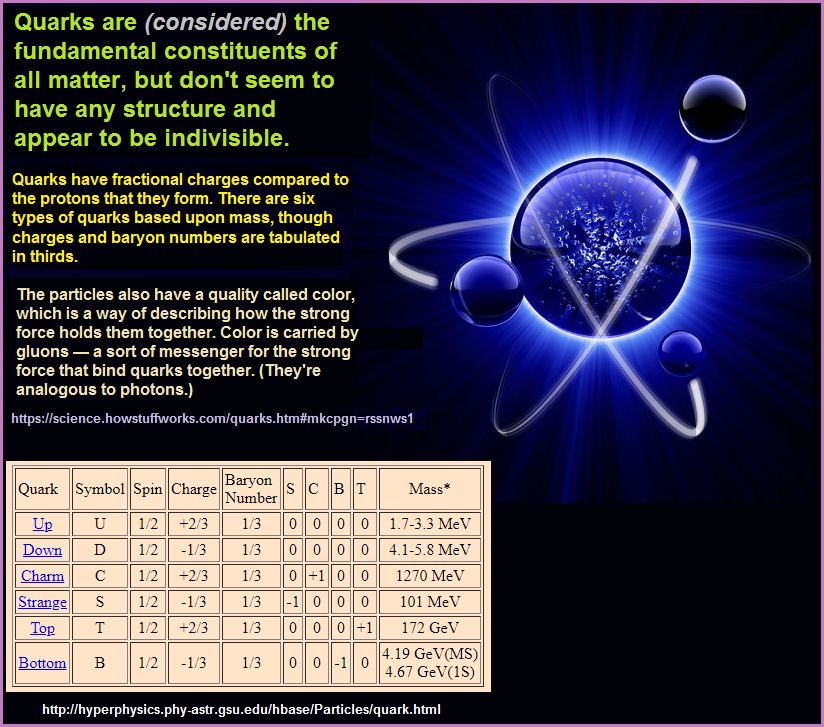
Please recall that I have already mentioned the three-patterned ensemble patterns of 2-3-4, 3-to("2)"-1 ratio and the 1, 2, many. There are others, but for the present, let us look once again at the third example and identify it in the following information discussing a supposed confirmation that atoms are both particles and waves using an experimental model expressing a pattern-of-two called the "double-slit" experiment, though such a reference quickly brings to mind the characteristic pattern-of-two found in studies of human behavior called the "double-blind" experiment, where people can metaphorically be viewed as atoms engaging in what can be described as particle and wave behaviors, though both experiments need to have their underlying formulas looked at from the perspective of three states of matter (solids- liquids- gases)... including that state being described as plasma, even though plasma may be a representative "thousands" in a group of unrecognized three similar to that group which follows the ones- tens- hundreds ensemble. In other words, while the ensemble of solids- liquid- gases is the cognitive thinking limit for many people, some have ventured into including the notion of "plasma", but have not considered this to be an expression of a cognitive limit which they are involved with... like the development of numbers in primitive thinking.
Antimatter Is Both a Particle and a Wave
New Experiment Confirms
By Rafi Letzter, Live Science, May 08, 2019
Antimatter isn't just made of antiparticles, it's also made of waves. Now we know that this holds true even at the level of a single antimatter particle.
Physicists have known for a long time that just about everything — light and other forms of energy, but also every atom in your body — exists as both particles and waves, a concept known as particle-wave duality. That's been shown again and again in experiments. But antimatter particles, which are identical to their matter partners, except for their opposite charge and spin, are much more difficult to experiment with. These twins of matter flit into existence fleetingly, usually in massive particle accelerators.
But now, physicists have shown at the level of a single positron — an antimatter twin of the electron — that antimatter, too, is made of both particles and waves. To show that positrons are also waves, the physicists performed a more complicated version of the famous "double-slit experiment," which in 1927 first showed that electrons — a form of matter — are both particles and waves.
[Strange Quarks and Muons, Oh My! Nature's Tiniest Particles Dissected]
In the original double-slit experiment, scientists fired a stream of electrons through a sheet with two slits on it, with a detector on the other side. If the electrons had been only particles, they would have formed a pattern of two bright lines on the detector. But they acted like waves, so they "diffracted" like light, forming a spread-out pattern of many alternating brighter and dimmer lines. (When two waves overlap but are shifted relative to each other, the peaks and valleys of the waves cancel out or add up, creating a distinctive pattern known as interference. These types of experiments are known as interferometry.)
In 1976, physicists figured out how to demonstrate the same effect with one electron at a time, proving that even single electrons are waves that can "interfere" with each other.
Physicists have since shown that when you bounce positrons o.. a reflective surface, they behave like waves. But until now, they had never performed a double-slit experiment showing that individual positrons had a wave nature. Doing that sort of experiment offers physicists opportunities to study the behavior of antimatter at a level that's deeper than ever before.
For this paper, (First demonstration of antimatter wave interferometry) published May 3 in the journal Science Advances, a team of Italian and Swiss physicists figured out how to generate a low-energy beam of positrons that could be used to perform the first antimatter version of the double-slit experiment. When the physicists directed the positrons through a more complex series of multiple slits, the positrons landed on the detector in a pattern you'd expect from waves, not individual particles.
"Our observation ... proves [the positron's] quantum-mechanical origin and thus the wave nature of the positrons," Paola Scampoli, a physicist at the Politecnico of Milano and co-author of the paper, said in a statement.
This work, the authors wrote, opens the door to a new kind of "interferometry" experiment. Next, they hope to answer questions about the wave nature of more complex exotic matter, and use those results to probe the nature of gravity at very small scales.
I read the above and had to laugh. The supposed brilliant scientists recreated an old experiment to provide a believe-in proof of their belief in it that it exhibited a truth they believed in (like so many religious fanatics do), instead of using all their presumed intelligence to create a different type of experiment with the knowledge of recurring cognitive patterns. Taking a bunch of particles like taking a bunch of 'bbs" (pronounced "bee-bees", as in bb-gun), or a bunch of pebbles, or a bunch of marbles and throwing them through two slits to hit a wall from which they bounce and calling the bounced reactions an interference that proves the marbles exhibit the actions of waves, is particularly stupid... and such supposed intelligent scientists should be embarrassed.
They played it safe. When do scientists ever play it safe, unless they are fearful of actually putting their minds and imaginations to the test to breech the territory of some new frontier. They simply re-created an experiment that many already believe in and use this to justify their own experimentation which is little more than a higher costing elaboration of a game that has already been played and played out time and again in the minds of those who pitch their bets on a sure thing, because the game and rules are designed accordingly. In short, they didn't experiment, they simply engaged in an elementary school level of artsy-craftsy, don't eat the glue, don't use pointed scissors, and work-together-nicely (place nice) activity.
We have a pattern-of-one (singular) idea (atoms), preferentially viewed as a pattern-of-two (waves/particles i.e. a "wavicale" or "wavicle"), subjected to a two-patterned experiment, from which arises the quantity of many (interference patterns). Hence, a three-patterned "one-two-many" ensemble.
Here is a variation of the two-slit idea I came up with awhile back:
What comes to mind for me is that tossing, throwing or shooting one, two or multiple atoms against a wall whose behavior is then looked at after it "bounces" off the wall and claiming this behavior as an indication that the atom-ball is also a wave, is rather silly. This is like saying the sound of a baseball after being hit by a bat proves its vibrations represents the ball as a wave. If not the metaphor of a baseball, then a golf ball, softball, basketball, football, tennis ball, or even metal ball. The type of wall and the type of underlying material which a ball is constructive of determines the resulting bounce and vibrational effect(s). Many of us understand this but it is not being directed towards experiments in physics because physicists enjoy a "halo" effect of some supposed unquestionable greatness like some sort of god-endowed infallibility. And many professionals are aware of this halo effect and take full advantage of it to manipulate the public into deference to a person's or institution's will.
No less, we assume that every single particle is constructed the same, without any variation, as if it is subjected to a manufacturing process whose Quality Control is beyond reproach. In other words, like a manufactured ball whose construction has multiple layers that a given manufacturing process is without error... ever, we assume that every single particle named an electron, or neutron, or proton, or muon, or gluon, or neutrino, or quark, etc., all have the same exact underlying structure without variance. Yet, even if we are as yet unable to detect any variances, this does not mean our thinking has to reflect a similar type of invariance in accepting so-called experimental proofs that provide proof of a previously believed in experiment and associated philosophy. This is stupid.
It is also stupid not to consider the presence of recurring patterns of cognition and how they effect accepted perceptions as truth. When an atom "bounces" off an obstruction ("wall"), what is being measured? The atom or an effect of an atom, such as we might use the sound of a tennis ball to define the form and nature of its structure. Along with a presumed wave, what if we develop a device to measure atomic level sounds? How are we to describe atoms then? As having three parts? And what if the sound is like the expression of a word or song? Whereas we already use the terms "color" and "flavor" in atomic physics, why not sound and feelings and all other anthropomorphic inclinations? Why not attribute imagination, love, hate and the dreaded persistent dichotomies of psychology and politically science? Perhaps the interactions of atoms can be viewed in terms of its own sociology and embryological configurations? Perhaps there are even atoms resembling the different stages of life development we see in different life forms, whereby we need to determine whether an atom's behavior is nature or nurture.
These physicists and their groupies have got to be kidding. Recreating a two-patterned experiment like kids playing a more expensive version of a game that has already been played out time and again, as a means of confirming the believed in rules, and thus attribute to themselves some supposed greatness for conducting what amounts to as a ceremonial address of conferring yet another award to that which has already been awarded, whereby they are in turn awarded for their participation in an award giving ceremony called a recreated experiment? How pathetically dumb can the physicist community get... and not just them, but other scientists doing the same thing in their respective areas of research? How can the public possibly become any smarter when those who are supposed to be the leaders blazing new trails, have created a system of ceremonializing repeated treks into the same domains that are described as difficult and costly, as a means of keeping others from venturing into the territories so as to see for themselves that present and past scientists want to rest on their laurels and expect others to do the same by not questioning the limits they are fearful of transgressing?
Heaven forbid anyone questioning the views of scientists, or theologians, or politicians, or doctors, or lawyers, or business executives, or the government, or any other authority in or out of an institution, family, social gathering, or singular relationship. Whereas the double-slit experiment was adopted as a standard by which to judge "The" nature of atoms, instead of "A" nature not only of atoms but of human cognition; those who confirm earlier experiments with greater costs and elaborations, they too become adopted as a standard, as a perceived to-be-believed-in criteria of truth akin to a natural law. Instead of being guilty by association, they become endowed with a certain greatness by association, when all they have done is confer an actual level of being able to express a finely-tuned sense of mimicry.
Another famous (I prefer to say "infamous") two-patterned ideas used for experimentation is that called the double-blind study or Wikipedia: Blinded experiment, which appears to represent a rationale and logical and reliable means of assessing truth.
Here are some definitions:
A double-blind study is a study in which both the person implementing the experiment and the participant(s) are not aware of which individual is receiving the experimental treatment. The purpose of a double-blind experiment is to ensure that the results are not biased. This approach is frequently used in the research field by not only scientists and psychologists but also in the legal process. The benefits of this type of study is the increase in reliability and validity of the experiment. (Examples of a Double Blinded Study Experiment by Susan J. Henrichon)
A double-blind study is one in which neither the participants nor the experimenters know who is receiving a particular treatment. This procedure is utilized to prevent bias in research results. Double-blind studies are particularly useful for preventing bias due to demand characteristics or the placebo effect by Kendra Cherry, Updated September 26, 2019
Double-blind placebo studies have been called the gold standard for testing medications, especially psychiatric ones. Since the placebo effect is a psychological one, it stands to reason that its effect on psychological conditions should be especially potent.
Typically, there are three groups: a control group, a placebo group, and a treatment group. The control group doesn't get a pill; if they get better over time—as is often the case with depressed people, for example—their improvement sets a baseline against which to compare the other two groups. When people in the placebo group improve more than the controls, their increased improvement can be attributed to the belief that the pill works. Only when people in the treatment group improve more than those in the placebo group can that additional improvement be attributed to the medication in the pill.
Unfortunately, there are significant problems with double-blind placebo studies. These have long been known in the research world, but for some reason, word hasn't gotten out to the public:
- In real life, when patients receive a prescription, they are implicitly told: "This is real medicine." In double-blind placebo studies, subjects are explicitly told: "This pill might be real medicine, or it might be a placebo." Obviously, these lead to different sets of expectations, with different effects.
- The other problem is the active placebos. Double-blind studies respond to the objection of experimenters unintentionally communicating whether or not a pill is a placebo. But they don't respond to the objection of the pill communicating that information.

Obviously, there are problems with the double-blind experiment as noted in the above example. Similarly, let us take a look at an argument posed against the foregoing mention of a double-slit experiment. I provide just a short narration of a longer article: (Next page)
Origination date: Sunday, October 13th, 2019... 4:36 AM
Initial Posting: Thursday, October 17th, 2019... 5:40 AM
Updated Posting: Friday, January 20th, 2023... 12:23 PM
Herb O. Buckland
herbobuckland@hotmail.com
